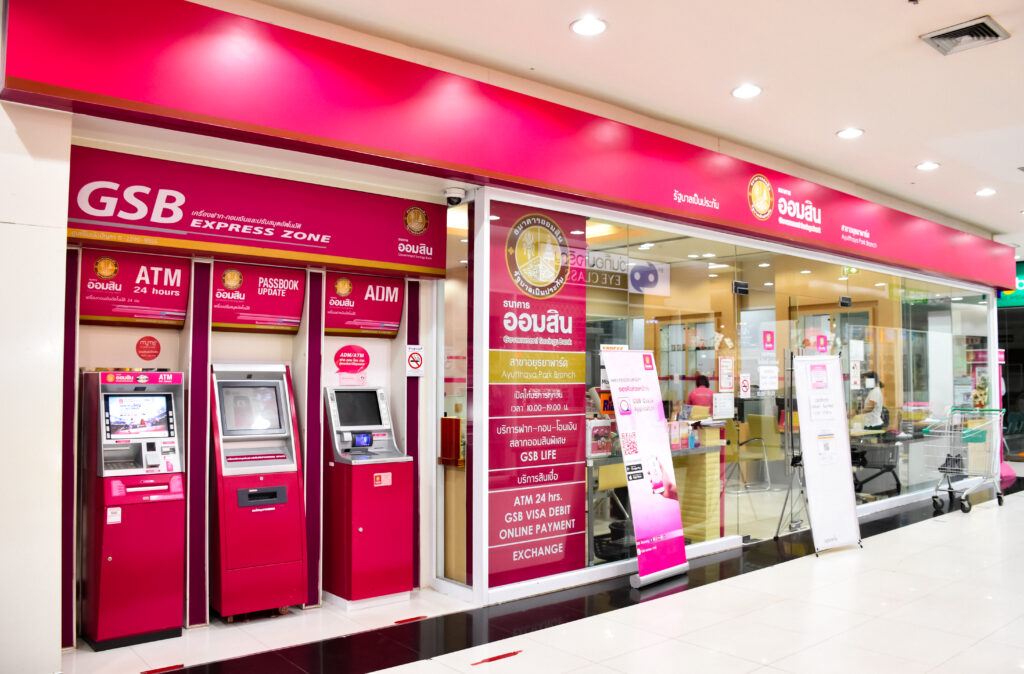Established in 1913, Government Savings Bank (GSB) is a state-owned Thai bank aimed to promote thrift and saving among Thai people. Fast forward to more than a century later, GSB grew to more than a thousand branches and mushroomed all over different parts of Thailand. At present, GSB has 1,060 branches in-country, more than any commercial bank, and has more diverse interests as well.
It has been guaranteed by the government under the supervision of the Ministry of Finance. GSB functions as a bank for the people of Thailand providing aid during economic crises and supporting efforts by the government to alleviate poverty by stimulating employment and earnings. Its services can be considered social welfare, as it supports and educates the public, including juveniles, students, and blue-collar workers.

Boonson Jenchaimahakoon, the first senior Executive Vice President (EVP) of Information Technology and Head of Digital Banking of GSB explains that the bank’s business is primarily retail banking.
“We have a similar culture and history to Singapore’s Post Office Savings Bank,’ he says, “as both banks have their origins in national post offices.”
There is an inherent tendency for long-established institutions to stick to their traditional ways, but GSB is not one of them. GSB has turned to open-source technology to drive digital transformation and realise its mission.
Jenchaimahakoon reveals that its use of Application Programming Interfaces (APIs) enables it to build up open banking. APIs allow different apps and software systems to communicate and exchange information, resulting in smoother and more efficient digital experiences.
He also pointed out the bank's adoption of a modular, microservices-based infrastructure that runs on Red Hat’s container platform. This has enabled the bank to maintain, modify, and scale existing services while keeping other applications and workloads running.
This means that GSB can update one application independently without affecting the operation of other services.
Transforming during the pandemic

Jenchaimahakoon recalls how the COVID-19 pandemic became instrumental in the digital transformation innovations of GSB, especially in pushing mobile banking forward.
“Pre-pandemic, everyone here in Thailand talked about digital transformation,” says Jenchaimahakoon. “There was a lot of talk, but taking action is another matter entirely.”
The GSB EVP says that mobile banking in Thailand became a “de facto standard before the pandemic. Nobody cared if bank branches closed, but if the mobile banking didn’t work, that was a big problem for the bank.”
At the onset of the pandemic, face-to-face transactions only happened rarely because customers and bank employees feared catching COVID-19 from in-person bank transactions. Despite this, bank transactions still needed to continue especially during times of crisis.
“Many people in Thailand lack savings, so quick loans are essential. This doesn’t change during a global pandemic,” notes Jenchaimahakoon. However, loan approvals during the pandemic posed special challenges. “It was difficult without in-person transactions at a bank branch. Qualifications and disbursement had to be done digitally.”
Because of those limitations, GSB had to adjust its strategy daily. “We needed to observe, learn, and make adjustments on the fly. One thing we implemented was a queueing system similar to what you would see at a bank branch, and this made our customers feel more confident in using the system,” he says.
We needed to observe, learn, and make adjustments on the fly.
GSB’s design principle for mobile banking, shares Jenchaimahakoon, is to emulate the face-to-face experience provided by a bank teller. “As a consumer, we want to see all of our information going back five years or so, just as a bank teller would,” he adds.
Digital Transformation Vision
Like other banks, GSB faced the same challenges when it came to adapting to an increasingly digital world and staying competitive by offering convenient experiences for customers. Like other banks, GSB also had to contend with existing legacy infrastructure and applications that supported the business.
How to modernise without disrupting the business and inconveniencing customers has become a primary objective in the execution of its digital transformation vision.
Despite the accelerated changes in mobile banking, GSB made very minimal changes to the internal IT systems, just enough to ensure that security is in place, connection is reliable, and data is protected.
As part of their digital transformation efforts, GSB adopted the OpenShift platform from Red Hat, which Jenchaimahakoon is thankful for because of how the platform manages the company’s APIs and how they (Red Hat) understood the business of GSB.
“I never focus on the name of the product,” Jenchaimahakoon says. “I know what I want. And if the technology from any vendor is suitable to support my vision – the ideas that I want to implement – that is the most important thing.”
His vision for digital transformation, he shares, “is to lay out everything simply and be able to solve problems whenever they arise.”
He says that a lot of companies look into technology to assess whether it can reduce necessary resources. He acknowledges that at GSB, “we first and foremost look at what our customers need, and only then whether the technology is ready to serve us and serve them.”
Speaking about his vision for digital transformation, Jenchaimahakoon values two things: open technology, and the support team. “Support and people are more important than the technology itself,” he confides. “Even if you have the best technology, without the right support from the team, the technology is useless.”
Transformation journey
According to Jenchaimahakoon, GSB's transformation journey is marked by constant learning. At the onset of the pandemic, for example, GSB served millions of customers a week through their digital loans and mobile banking platforms. They had to quickly learn to manage a large number of people digitally daily.
“The second learning,” he adds, “is replicating whatever is in the physical into the digital world.” GSB undertook modernising long-established processes as they went through digitalisation.
The bank recognised that banking is a people business, and it is important to respect the established preferences of customers while steering them towards new and more convenient ways of doing business with the bank.
He points out that “innovation has to reflect something new to the market that addresses the pain points of the customer."
Innovation has to reflect something new to the market that addresses the pain points of the customer.
He admits that it was not easy to translate these visions into reality. He built a small pre-selected team of seven people he referred to as the Innovation Team and trained them to make sure that even after he retires, the innovation mindset will continue.
As an encouragement to people who look up to him, especially to his team, he shares that they “should try to contribute to the organisation, not trying to find what we can get from them, but what they can do as long as they work for them.”
* Editor's notes: This article is part of the Cxociety Coffee Table Book project (The Project) which chronicles the journey and experiences of senior business, operations, finance and technology leaders in Asia in recent years. The Project illustrates the tenacity, ingenuity and resiliency of the human spirit in the face of seemingly endless challenges.
With nearly 50 stories chronicled in The Project, it is a must-read compendium of learnings and experiences from seasoned professionals in the region.





